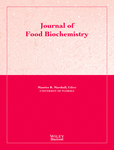EFFECT OF PHENOLIC COMPOUNDS FROM ARGENTINEAN RED WINES ON PATHOGENIC BACTERIA IN A MEAT MODEL SYSTEM
Abstract
ABSTRACT
In this work, the effectiveness of phenolic compounds of different varieties of wines as antibacterial agent in a meat model system was determined. Total phenolic, flavonoid and flavanol compounds concentrations were greater in Merlot and Malbec wines compared with Cabernet Sauvignon variety. In meat, the best antibacterial effect of wine phenolic compounds against both bacteria was observed with Merlot and Malbec wine varieties at 4C, even when inhibitory effect was also observed at 20C. The lowest decimal reduction time was obtained with Merlot wine for Listeria monocytogenes and with Malbec and Merlot wines for Escherichia coli. From our results, we propose the use of wine phenolic compounds as natural biopreservatives for meat in combination with low temperatures. These natural products provide the additional human health benefit inherent to polyphenols properties.
PRACTICAL APPLICATIONS
The exploration of natural antimicrobials for food preservation receives increased attention due to a growing microbial resistance towards conventional preservatives, added to consumer awareness of natural food products. The antibacterial effect of individual phenolic compounds in culture media has been largely studied,, but there is no information about the antibacterial effect of natural combinations of polyphenols from different varieties of wines in meat. In this work, we demonstrate that phenolic compounds combination of Argentinean wines were effective in inhibiting the growth of two pathogenic bacteria that produce food contamination and illness in the consumer. Natural polyphenol combinations found in Argentinean wines could act as natural biopreservatives for meat in combination with low temperatures, achieving extension of the shelf life of food.




